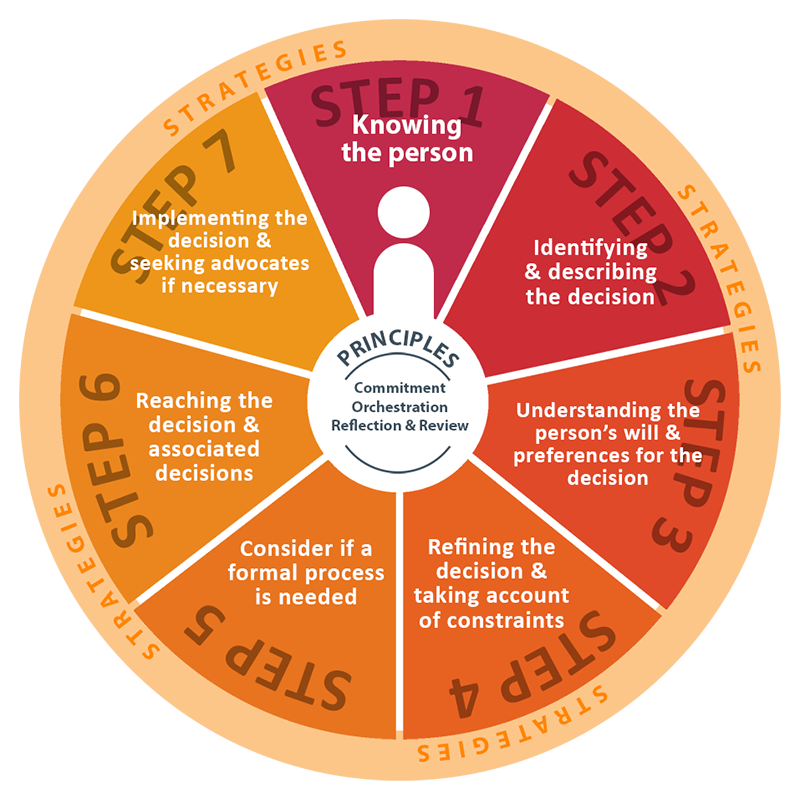Case Scenario: Tanya has decided that she wants to go on a date.
Using Tanya's scenario, all of your learning about the Framework will be brought together and summarised in this module.
In this module, you will be reminded that:
- The Principles and Strategies are intertwined with every Step in the Framework
- Decision making is shared between the person and those who support them
- Continuing support should be provided for new and consequential decisions.
Case Scenario: Tanya's Date
This case scenario is presented in 3 parts.
Part 1: Tanya is a 30-year old female with mild traumatic brain injury. She enjoys going to the gym, and attends at least twice a week with her support worker. On this particular day, she meets someone new at the gym.
Part 1: Tanya is a 30-year old female with mild traumatic brain injury. She enjoys going to the gym, and attends at least twice a week with her support worker. On this particular day, she meets someone new at the gym.
Watch this video which further introduces this scenario, then read on.
Part 2: Tanya is noticeably excited that Jason has asked her to meet up with him sometime. When she returns home her supporters, her mother and her support worker, discuss her encounter.
Watch this video which shows Tanya's supporters having a discussion, then read on.
Part 3: Tanya’s supporters feel conflicted about Tanya meeting up with someone. They decide that the way forward is to sit down and talk it out with Tanya.
Watch the video which shows the discussion between Tanya, her mother and support worker about her wanting to go on a date, then read on.
The Support for Decision Making Checklist
Using the Support for Decision Making Checklist will enable you to understand how the Framework has been applied to support Tanya's decision. Tanya's checklist has been completed for you as an example of how this checklist can be used. Access it via the Resources section.
A blank checklist is also provided for you in the Resources section. You can use this in your own work.
A blank checklist is also provided for you in the Resources section. You can use this in your own work.
Read the questions then write your answer in the downloadable workbook located in the Resources section.
Think about someone with a cognitive disability who you have supported to make a decision then answer the questions below.
Think about someone with a cognitive disability who you have supported to make a decision then answer the questions below.
- With this scenario in mind complete the Support for Decision Making Checklist. (Note: You can follow Tanya’s example provided in this Module).
- Thinking about the decision-making support you provided for this person, is there anything you would do differently next time?
Closing Comments
You have now learnt how to use the La Trobe Support for Decision Making Practice Framework to support people with cognitive disabilities.
The Framework guides you through the Steps of decision making support, while the Principles inform all of your Strategies. The Framework is dynamic – you can go forwards or backwards through the Steps. It has also been designed to enable decision making support to be tailored to the person and their situation.
Through ongoing reflection and by applying what you have learnt from this online resource, you will enable people with cognitive disabilities to participate in making their own decisions.
The Framework guides you through the Steps of decision making support, while the Principles inform all of your Strategies. The Framework is dynamic – you can go forwards or backwards through the Steps. It has also been designed to enable decision making support to be tailored to the person and their situation.
Through ongoing reflection and by applying what you have learnt from this online resource, you will enable people with cognitive disabilities to participate in making their own decisions.
Summary Module 6
This Module has highlighted that you should:
- Tailor the support to the person and their situation
- Maintain positive expectations
- Always keep the person’s preference at the heart of decision making.



